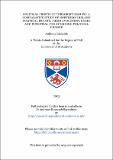Files in this item
Political fronts of terrorist groups : a comparative study of Northern Ireland political fronts, their evolution, roles and potential for attaining political change
Item metadata
| dc.contributor.advisor | Wilkinson, Paul | |
| dc.contributor.author | Richards, Anthony | |
| dc.coverage.spatial | v, 400 p. | en_US |
| dc.date.accessioned | 2018-06-21T12:18:25Z | |
| dc.date.available | 2018-06-21T12:18:25Z | |
| dc.date.issued | 2003 | |
| dc.identifier.uri | https://hdl.handle.net/10023/14395 | |
| dc.description.abstract | This thesis outlines the evolution and roles of the political fronts in Northern Ireland and their potential for attaining political change. It will assess the impact of a number of selected 'variables', both 'internal' and 'external', on the utility (or lack of utility) of these fronts. The variables that have been selected for consideration are: 1) Ideology, structure and leadership, 2) The notion of violence as a habit, 3) Popular support, 4) State response and 5) Other factors and events in the External Environment. Alexander George's 'structured, focused, comparison' methodology will be employed and the selected cases are the Irish Republican Army, the Ulster Defence Association and the Ulster Volunteer Force. Although all of the 'variables' have had a significant impact the thesis argues that the greatest motivation behind the use of Simi Fein has been the desire to mobilise or tap perceived existing support. In the case of the loyalist political fronts the domestic external environment, specifically the perception that the loyalist working classes had been manipulated by 'respectable' unionist politicians, was the most important factor behind their greater use. Paradoxically, it is unionist culture (such as its 'law abiding' nature and division of labour ethos) that has presented the most significant obstacle to their utility. The thesis will then assess whether or not political fronts represent moderation towards the use of violence on the part of the groups. It will suggest that they have in the loyalist cases. Although the following argues that political fronts are very much part of the 'terrorist machinery' as the political voices and propaganda outlets for terrorist groups, and that it is a misconception to view them as the 'moderate half of a movement, the thesis will contend that Sinn Fein has also ultimately come to represent moderation towards the use of violence. The conclusion will then suggest that the selected variables be tested in other examples and, assuming that Sinn Fein has come to represent moderation towards the use of violence, will then attempt to draw some lessons from the case of the IRA and its political front that might be considered when studying other cases. | en_US |
| dc.language.iso | en | en_US |
| dc.publisher | University of St Andrews | |
| dc.subject.lcc | HV6433.I73R5 | |
| dc.subject.lcsh | Terrorism--Northern Ireland | en |
| dc.subject.lcsh | Northern Ireland--Politics and government | en |
| dc.subject.lcsh | Political violence--Northern Ireland | en |
| dc.subject.lcsh | Sinn Fein | en |
| dc.title | Political fronts of terrorist groups : a comparative study of Northern Ireland political fronts, their evolution, roles and potential for attaining political change | en_US |
| dc.type | Thesis | en_US |
| dc.contributor.sponsor | Economic and Social Research Council (ESRC) | en_US |
| dc.type.qualificationlevel | Doctoral | en_US |
| dc.type.qualificationname | PhD Doctor of Philosophy | en_US |
| dc.publisher.institution | The University of St Andrews | en_US |
This item appears in the following Collection(s)
Items in the St Andrews Research Repository are protected by copyright, with all rights reserved, unless otherwise indicated.

